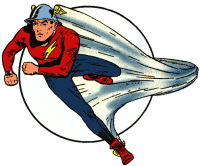See Also: Series, Books & Specials, Modern Writers
 Golden Age Origins
Golden Age Origins
In 1940, writer Gardner Fox (1911–1986) and artist Harry Lampert (1916–2004) created the Flash for All-American Comics, which published under the DC Comics label. With powers and costume inspired by the Greek/Roman god Mercury, Jay Garrick made his debut in Flash Comics #1. Edited by Sheldon Mayer (1917–1991), the series featured the Flash, Hawkman, and a rotating cast of other heroes.
In the early years of super-hero comics, filled with multi-powered Superman clones or multi-gadgeted Batman clones, the Flash was “the first specialty super-hero.” It might be hard to relate to someone who could fly, but just about everyone knew what it was like to run, and could imagine running like the wind. The Flash proved so popular he gained a series of his own, All-Flash Quarterly in 1941 (soon shortened to just All-Flash), and a regular spot in Comic Cavalcade in 1942.
Criminals and Comedians
At first the Flash battled ordinary criminals: racketeers, kidnappers, or thieves. Occasionally he would match wits with a mad scientist (or, more likely, ordinary crooks who had made of with an invention). It took nearly three years for his first super-powered enemy, the Shade, to appear in Flash #33 (1942). Even then, recurring villains were rare until late in the decade, when the Fiddler and Thinker racked up four return appearances each. (The Shade himself didn’t return until 1961, well into the Silver Age!)
The book was often “comic” in more ways than one. It would use slapstick humor and puns, and the Flash acquired a trio of comedic sidekicks, the Three Dimwits. Their stories were cartoony and focused as much on the comedy as the adventure.
The Sincerest Form of Flattery
The speedster quickly became an archetype, and imitators were soon racing through other publications. Quality Comics introduced Quicksilver later that year. DC added a second speedster—one that they owned outright—in 1941: Johnny Quick. And with all the good names taken, the future Marvel Comics created the Whizzer.
Interestingly, DC now owns all the Golden-Age speedsters but the Whizzer. A 1945 feud[1] between DC and All-American ended when DC bought out the entire line. After Quality Comics went out of business in 1956, DC bought their line-up. The trademark on Quicksilver lapsed, though, and Marvel introduced their own super-speed mutant with the name in 1964. When Mark Waid re-introduced the original in 1993, he renamed the character Max Mercury. The Whizzer, meanwhile, took a circuitous route back to the source, as Marvel reused the name when creating their JLA stand-ins, the Squadron Supreme.
Fading Away
Interest in comic books dropped off by the end of the decade. (Unless you count crusades against comics by people who blamed them for juvenile delinquency.) Nearly all super-heroes faded from view during the early 1950s, only the “big three”—Superman, Batman, and Wonder Woman—surviving intact. All-Flash closed down in 1948, the Flash lost his space in Comic Cavalcade, and Flash Comics finished up with #104 in 1949.
To be continued...
Text by Kelson Vibber. Do not copy without permission. Primary Sources
Primary Sources
- The Golden-Age Flash Archives #1 (1999): Foreword by Mark Waid
- The Comic Cavalcade Archives #1 (2005): Foreword by Michael Uslan and Robert Klein
- The Silver-Age Flash Archives #1 (1996): Foreword by Paul Kupperberg
- The Greatest Flash Stories Ever Told (1991): Foreword by Carmine Infantino
- The Greatest Flash Stories Ever Told (1991): Introduction by Mike Gold
- The Greatest Flash Stories Ever Told (1991): “The Final Flash Storyline,” Cary Bates
- The Official Teen Titans Index #1 (1985), Murray R. Ward
- Don Markstein’s Toonopedia
Art
- Golden Age: Flash Comics #14 (by way of the Golden Age Flash Archives #1) (November 1999) - E.E. Hibbard
- DC and All-American Logos: All-Flash #20 and #24 (1945–1946)
Notes
 [1] DC vs. All-American.
In 1939, DC Comics owner Harry Donenfield contracted with Max Gaines to publish
additional comics under the DC label. Gaines set up All-American Comics, which
developed characters such as the Flash, Green Lantern, and Wonder Woman.
By 1945 the relationship had soured to the point that All-American started
publishing under their own label. Flash Comics #62–67,
All-Flash #17–20, and Comic Cavalcade #10–12
appeared as AA comics instead of DC. The result: DC Comics bought out the
entire All-American line, and the books returned to the DC label.
(Comic Cavalcade Archives #1, 2005)
[1] DC vs. All-American.
In 1939, DC Comics owner Harry Donenfield contracted with Max Gaines to publish
additional comics under the DC label. Gaines set up All-American Comics, which
developed characters such as the Flash, Green Lantern, and Wonder Woman.
By 1945 the relationship had soured to the point that All-American started
publishing under their own label. Flash Comics #62–67,
All-Flash #17–20, and Comic Cavalcade #10–12
appeared as AA comics instead of DC. The result: DC Comics bought out the
entire All-American line, and the books returned to the DC label.
(Comic Cavalcade Archives #1, 2005)
Related Commentary
- 50 Years of the Flash at Comic-Con 2006
- Happy Birthday, Barry! at Crimson Lightning